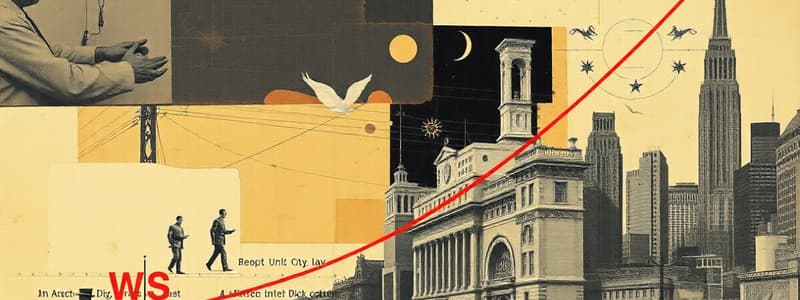Podcast
Questions and Answers
Quelle affirmation décrit le déplacement de la courbe WS en période de prospérité économique ?
Quelle affirmation décrit le déplacement de la courbe WS en période de prospérité économique ?
- La courbe WS se déplace vers le bas.
- La courbe WS ne change pas.
- La courbe WS devient horizontale.
- La courbe WS se déplace vers le haut. (correct)
Quel facteur n'influence pas la position de la courbe WS ?
Quel facteur n'influence pas la position de la courbe WS ?
- Les politiques gouvernementales.
- Le pouvoir de négociation des ouvriers.
- Les tendances inflationnistes.
- La distance géographique des entreprises. (correct)
Comment les augmentations de productivité affectent-elles la courbe WS ?
Comment les augmentations de productivité affectent-elles la courbe WS ?
- Elles la déplacent vers le haut.
- Elles la déplacent vers le bas. (correct)
- Elles la rendent plus plate.
- Elles n'ont aucun effet.
Quel rôle les syndicats jouent-ils en relation avec la courbe WS ?
Quel rôle les syndicats jouent-ils en relation avec la courbe WS ?
Quel facteur peut entraîner une diminution des demandes salariales, influençant la courbe WS ?
Quel facteur peut entraîner une diminution des demandes salariales, influençant la courbe WS ?
Quel est l'impact des lois sur le salaire minimum sur la courbe WS ?
Quel est l'impact des lois sur le salaire minimum sur la courbe WS ?
Quelle est la conséquence des attentes inflationnistes sur la courbe WS ?
Quelle est la conséquence des attentes inflationnistes sur la courbe WS ?
Comment les conditions économiques générales affectent-elles la courbe WS ?
Comment les conditions économiques générales affectent-elles la courbe WS ?
Flashcards
WS Curve
WS Curve
Relationship between real wage and employment; shows nominal wage firms pay at equilibrium employment.
Upward-sloping WS Curve
Upward-sloping WS Curve
Higher employment levels typically correspond to higher real wages.
Firm Market Power
Firm Market Power
Influence of large firms on wage negotiation, often leading to less wage adjustment in response to employment changes.
Worker Bargaining Power
Worker Bargaining Power
Signup and view all the flashcards
Productivity Shift (WS)
Productivity Shift (WS)
Signup and view all the flashcards
Economic Conditions (WS)
Economic Conditions (WS)
Signup and view all the flashcards
Minimum Wage (WS)
Minimum Wage (WS)
Signup and view all the flashcards
WS Curve Position Determinants
WS Curve Position Determinants
Signup and view all the flashcards
Study Notes
Introduction
- The WS curve (Wage-Setting) represents the relationship between the real wage and the level of employment.
- It illustrates the nominal wage that firms are willing to pay workers considering the equilibrium level of employment.
- The WS curve is upward sloping, indicating that higher employment levels are associated with higher real wages.
Factors Influencing the WS Curve Shape
- Market power of firms: Larger firms typically have more negotiating power, leading to less responsive wage adjustments to employment levels.
- Bargaining power of workers: Strong labor unions or worker organization can lead to real wages that are relatively insensitive to employment changes.
- Expectations: Expected inflation and future wage adjustments affect worker and firm expectations. Higher expected inflation implies a higher nominal wage demand.
- Productivity: Increases in labor productivity will reduce wage demands. Higher productivity thus leads to a shift downwards in the WS curve.
- Unemployment rate: Higher unemployment levels often correlate with reduced wage demands, with a corresponding shift downwards or left in the WS curve.
- Economic Conditions: Overall economic prosperity or downturns influences real wages and employment. More expansionary conditions can lead to a shift upwards and to the right
- Government policies: Wage policies or minimum wage laws often influence the shape and position of the WS curve.
Determinants of the WS Curve's Position
- Productivity: Higher productivity tends to shift the WS curve downwards as firms can afford to pay higher wages while still delivering profits.
- Worker bargaining power: Strong labor unions or worker organization usually lead to a higher position of the WS curve.
- Economic conditions: A buoyant economy often leads to a shift upwards in the curve, as both firms and workers demand higher wages. Conversely, during recessions, the WS curve shifts downwards.
- Legal minimum wages: Minimum wage laws directly impact the WS curve by establishing a minimum that firms must pay. Higher minimum wages result in a shift to a higher position.
- Social norms: Expected wages and social norms about wages influence workers' demands and firms' willingness to pay.
- Wage indexation: When contracts adjust wages based on inflation, it directly affects the position of the WS curve.
Intersection with the PS Curve
- The WS curve intersects with the PS curve (Price-Setting) curve to determine equilibrium real wage and employment levels.
- The point of intersection is crucial in determining the equilibrium employment and wage rates.
Shifts of the WS Curve
- Changes in labor market conditions: Stronger or weaker labor unions, productivity shocks, and changing unemployment levels all cause shifting in the curve.
- Public policies: For example, government-mandated wage increases or minimum wage laws will cause upward shifts in the WS curve.
- Inflation expectations: Changes in inflation expectations will produce an upward or downward shift in the WS curve depending on whether expectations increase or decrease.
Studying That Suits You
Use AI to generate personalized quizzes and flashcards to suit your learning preferences.




